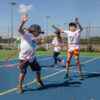
by Ellen Martin
Help Me to Talk
It can be difficult to know how to encourage the development of your child’s communication skills. There are lots of things you can do at home to help. Here are my top 10 strategies for helping your child’s communication.
1 Get down to your child’s level
When communicating with your child, get down and be at their level. Play with them face to face where possible, hold toys up to your face this will draw your child’s attention to you. For example, you could kneel or sit on the floor holding a bubble pot close to your face.
2 Watch and wait
We can often respond to children’s nonverbal requests and needs before they have even initiated them. As parents, you know when your child gets hungry, and you know what snack they will want. So, you pre-empt it, you already have the snack ready before they realise they wanted one! This can remove the need for interaction. Watch your child and wait, see if they will tell you in some way that they are hungry or want something. This could be verbally or it may be through gesture. For example, they may take your hand and guide you to the biscuit tin!
3 Naming/commenting
Simple is key when learning language. Label what you see, keep it to one word, and keep it simple. For example, when playing with bricks you might say “oh look a big red brick”, instead you could say “brick”. Think about what target words you would like your child to say or learn.
4 Use gestures
Use a gesture or sign when you name or do something. Gestures provide a concrete visual representation and can help your child to understand what you are saying. Make sure with any gesture you are still saying the word. We want the gestures to support talking development, not replace it. Some children do pick up gestures before words, but it is important to continue to model the words.
5 Reduce the questions
When we are asked a question, especially one we do not know the answer to, we feel under pressure. This is the same for children when we ask them questions. They can feel put on the spot, which is difficult for children who are learning to talk. Instead, use a naming or commenting approach and explain what is happening. So rather than asking your child “what’s that?” tell them what it is, give them the opportunity to learn language.
6 Offer choices
Offer your child a choice of two things, for example, at snack time you could offer a banana or a cereal bar, make the choice visual. As you offer each one hold the item up, so it is clear what you are referring to. Offering choices encourages a child to interact, especially when it is something as motivational as food or toys! Your child may indicate their choice using words or gestures.
7 Repeat, repeat, repeat
We learn best when things are repeated, and children are no different. Repeat key words or gestures over and over during play or in your daily life. This will help your child to link the word/gesture with the action or object.
8 Functional communication vs ‘ABC’ and ‘123’
It’s important your child can express their needs and wants using functional communication. This may include words such as ‘go’, ‘more’, ‘help’ ‘stop’ and ‘open’. Words that can be used on their own to communicate but also built on to increase communication. Shapes, letters and numbers aren’t as useful when it comes to communication as they can’t be used to express needs or wants.
9 Follow your child’s lead
We often try to teach children as they play or direct them towards a new activity. Whilst this may create more opportunities for them it can limit communication. Children are more likely to communicate in a familiar activity they enjoy. Allow your child to show you what they enjoy, follow their lead and join in with their play and interactions. You can then use language appropriate to their interests which will help build language and attention skills.
10 Pausing – count to 10 and then give them time
When we are learning something new we need time. Time to listen, process and then respond. This is the same with learning language. By pausing and counting to 10 in your head, we give children time to understand what you have said and respond. If after pausing, they do not respond you can model the words/gestures you would like them to use.
If you would like more strategies and support with your child’s communication skills, then please do get in touch. Help Me To Talk provide engaging sessions at home, nursery, school and virtually to families across Surrey and Hampshire. For children as young as two years old.










